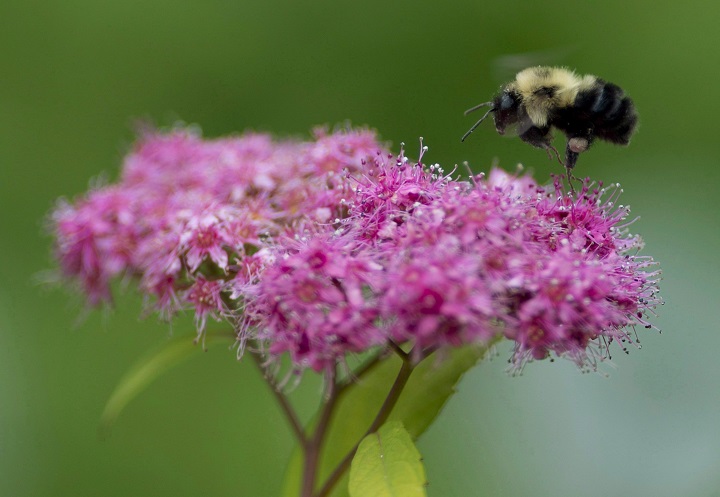As concerns remain about protecting at-risk insect pollinators essential for food development, City of Toronto staff are recommending several new measures to increase and improve the habitats of bees, butterflies and other insects.

The pollinator protection strategy is going to the City’s parks and environment committee on April 9 for consideration. It contains 30 actions that Toronto staff and residents can take to help the insects.
BEE FRIENDLY: City of Kawartha Lakes stands up for pollinators
“We want people to recognize the value of pollinators … a very large percentage of every forkful you take is food that is pollinated by a bee or a butterfly, they play a pretty important role in our ecosystem,” Mark Bekkering, manager of policy and research for the City of Toronto’s environment and energy division, told Global News.
“We want people to recognize the diversity and how important the diversity is and it’s not necessarily just solely about the honey bee, which is largely a commercial enterprise.”
According to the report, there are more than 360 species of native bees, 112 butterfly species and the European Honey Bee (which is regulated by provincial law and colonies are overseen by bee keepers).
“While the primary focus is the protection of native pollinators, the foundation of the strategy is habitat creation, which will benefit all pollinators,” the report said.

Get daily National news
READ MORE: Why urban beekeeping is trending in Canada
“Bees provide the invaluable service of pollination, allowing plants to produce seeds, fruits, and new plants. Without bees, our natural landscapes and food could not exist. One in three bites of food relies on bee pollination.”
The report also outlined the importance of butterflies, noting caterpillars (butterfly larvae) are herbivores and food for birds. It said a decline in pollinators should be a source of concern.
“Pollinators are under increasing stress due to habitat loss, invasive species, diseases, pesticides and climate change. As a result, some species are in decline … Once native species are lost, they cannot be replaced,” the report said.
“Recent studies indicate that honey bees may negatively impact native pollinators due to resource competition and the unintended spread of parasites and disease.”
Councillors are being asked to approve the strategy’s recommendations, which are still subject to city council approval and include:
- creating an annual $100,000 grant program in 2018, 2019 and 2020 to support community-led projects that create and enhance pollinator habitat on public or private lands, as well as education programs (staff said they hope the program will attract private-sector donations)
- enhancing, protecting and creating habitats in natural and urbanized areas
- declaring the metallic green sweat bee Toronto’s official bee in order to build a public education campaign to raise awareness of native bee species
- declaring Toronto a monarch butterfly-friendly city through a mayoral pledge
Sarah Doucette, Ward 13 Parkdale-High Park councillor and vice chair of the City of Toronto’s parks and environment committee, told Global News she backs what the report is trying to achieve.
“Every time we’re developing a piece of open space and putting concrete or asphalt over it, we are killing the habitat of these native bees,” she said.
READ MORE: Widely used neonicotinoid pesticide puts bumblebee colonies at risk, study finds
“This whole pollination strategy is to preserve the environment that we have and to protect our native bees, which can often get killed off by the honey bee because the honey bee is more of a forager and goes after a lot of the nectar that keeps our native bees alive.”
Doucette said the city has already taken actions to make Toronto’s green spaces more pollinator-friendly, such as protecting naturalized areas, reducing the use of pesticides and not buying plants and seeds that contain neonicotinoids (a substance that can kill insects).
She encouraged residents to plant native plants that can help pollinating insects.
“Everyone can help. Even if you live in an apartment building or a condo and you have a balcony, plant something that will encourage the bees and the butterflies.”
The Canadian Wildlife Federation has a list of plants native to Ontario under the detailed search function of its encyclopedia. In a guide for creating and enhancing habitats for pollinators, Credit Valley Conservation suggests putting in plants such as roses, sumac, sunflowers, echinacea, goldenrod and raspberry.








Comments